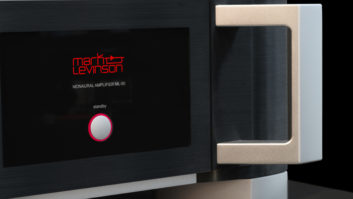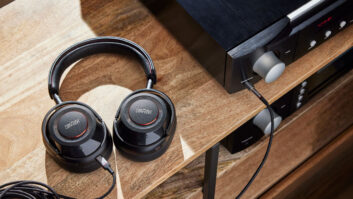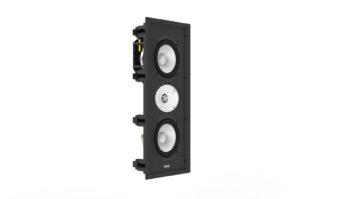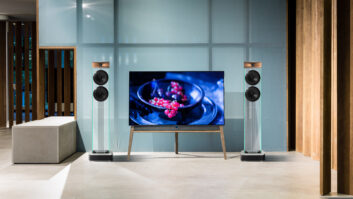At CEDIA EXPO this month, Harman’s Luxury Audio Group making enhancement to two of its popular brands in somewhat different ways. While Revel will demonstrate its ability to offer “exceptional performance with outstanding value and easier installation,” Mark Levinson’s newest product is “making a statement” with a premium-priced, high-performance and elegant addition.

The Mark Levinson No. 52 is an all-analog, true dual-monaural design with a two-chassis configuration that separates the analog audio circuitry from the (digital) control section to maintain the purest signal paths possible.
As its previously introduced Performa3 Series cabinet speaker line moves into full production, Revel will unveil its 2-Series in-wall and in-ceiling loudspeakers at CEDIA, and Mark Levinson is introducing the No. 52 reference dual-monaural preamplifier.
Jim Garrett, Harman Luxury Audio Group and Loudspeakers director of marketing and product management, said although the main goal for the Revel 2-Series was to accommodate installation challenges such as double drywall construction in high-end homes, it will also feature a lower entry price for the premium brand. “It’s still a higher performance product, but it will include fewer features like attenuators and will include a fixed tweeter,” Garrett explained.
Whereas the previous least-expensive Revel architectural two-way speaker had been $500/pair, the brand is now targeting its new C263 in-ceiling at $350/pair. The seven speakers in the Revel 2-Series include the C263 (1-inch tweeter, 6.5-inch woofer), C283 in-ceiling speaker (1-inch tweeter, 8-inch woofer), C263LP low-profile in-ceiling speaker (1-inch tweeter, 6.5-inch woofer), C283LP low-profile in-ceiling speaker (1-inch tweeter, 8-inch woofer), W263 in-wall (1-inch tweeter, 6.5-inch woofer), W283 in-wall speaker (1-inch tweeter, 8-inch woofer), and W253L horizontal/vertical in-wall LCR speaker (1-inch tweeter, dual 5.25-inch woofers).
All models, with the exception of the C263LP and C283LP low-profile solutions, employ the company’s new C-2 dog-leg-type clamping mechanism that locks the speakers into place and can be used with materials up to 2 inches thick. All feature zero-bezel magnetically removable paintable grilles. All 2-Series speakers also fit into existing pre-construction brackets and fire-rated back box accessories.
For Mark Levinson, the goal for the first of what will be four new products for the brand, was to reinforce its reputation as a brand that is 100-percent designed, engineered and manufactured in-house and in the U.S. The No. 52 is an all-analog, true dual-monaural design with a two-chassis configuration that separates the analog audio circuitry from the (digital) control section to maintain the purest signal paths possible. It provides three balanced XLR and four unbalanced RCA line-level inputs, and a dedicated phono input that is selectable for moving coil (MC) or moving magnet (MM) operation. Two sets of XLR and RCA stereo preamplifier outputs are provided, along with an auxiliary pair of XLR and RCA outputs that can be configured for fixed or variable level output with independent source selection. This enables the auxiliary outputs to function either as a third preamp out, a pass-through full-range subwoofer output or a record output.
“As our first new Mark Levinson product in a few years, it was important to do the reference piece first, as a statement about the future of the brand,” Garrett said. “And this is a clean-sheet design from our team. For us it’s about staying true to what the brand means.”
An Update on JBL Synthesis
After making the decision to discontinue plans for its MP20 media controller product, Harman has a new strategy for its JBL Synthesis line.

Jim Garrett
“Creating a premium-quality SSP [surround sound processor] from the ground up like we were trying to do was more difficult than we realized it would be,” Harman’s Jim Garrett said. “It truly is a moving target.”
So, although Harman plans to use certain aspects of the MP20 (such as the Quantum Logic surround algorhythm) in other products, JBL Synthesis will take a different tact in creating a new SSP. The company is working with a brand that it has “worked with in the past” and an ODM (original design manufacturer) on creating a rebadged version of an existing SSP.
Garrett said that because Synthesis is more about creating a complete system, rather than focusing on a 100-percent in-house design for SSPs, this approach is appropriate for the brand.
“What makes Synthesis cool is the custom tuning that goes into those systems,” Garrett said. “They’re basically tailored suits. Every Synthesis is custom spec’d for the project and custom tuned into the room. The processor is not the secret sauce.”







